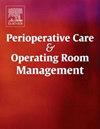Effects of propofol-fentanyl and dexmedetomidine-ketamine combinations on haemodynamic status with laryngeal mask airway insertion in adults
IF 1
Q2 Nursing
Perioperative Care and Operating Room Management
Pub Date : 2025-06-24
DOI:10.1016/j.pcorm.2025.100514
引用次数: 0
Abstract
Introduction
The induction of anaesthesia is a critical phase that ensures a controlled and safe surgical experience. This study evaluates the comparative effects of Propofol-Fentanyl and Dexmedetomidine-Ketamine combinations on haemodynamic stability during laryngeal mask airway (LMA) insertion in adults undergoing elective surgeries.
Methodology
A randomized controlled trial was conducted at the Department of Anaesthesiology, Vinayaka Mission’s Medical College, Karaikal, over two years. ASA I and II patients aged 18-60 years with a BMI of 18.5-29.9 kg/m2 were recruited and randomized into two groups: Group A (Propofol-Fentanyl) and Group B (Dexmedetomidine-Ketamine). Haemodynamic parameters, ease of LMA insertion, and complications such as apnoea, coughing, swallowing reflexes, and laryngospasm were assessed.
Results
The study found no significant difference in demographic variables between the two groups. Heart rate and blood pressure remained stable throughout the procedure, with Group A exhibiting higher heart rates at 15 minutes and post-operatively. Oxygen saturation levels were comparable, and both groups demonstrated similar ease of LMA insertion and incidence of complications.
Conclusion
Both anaesthetic combinations are effective for LMA insertion, but Dexmedetomidine-Ketamine provides superior haemodynamic and respiratory stability, supporting its use in patients requiring tighter perioperative hemodynamic and respiratory control.
异丙酚-芬太尼和右美托咪定-氯胺酮联合应用对喉罩插管患者血流动力学的影响
麻醉诱导是确保手术可控和安全的关键阶段。本研究评估了异丙酚-芬太尼和右美托咪定-氯胺酮联合使用对成人择期手术喉罩气道(LMA)置入期间血流动力学稳定性的影响。方法在Karaikal市Vinayaka Mission医学院麻醉科进行了一项为期两年的随机对照试验。招募年龄18-60岁、BMI为18.5-29.9 kg/m2的ASA I和II级患者,随机分为a组(异丙酚-芬太尼)和B组(右美托咪定-氯胺酮)。评估血流动力学参数、LMA插入的难易程度以及呼吸暂停、咳嗽、吞咽反射和喉痉挛等并发症。结果两组在人口学变量上无显著差异。心率和血压在整个手术过程中保持稳定,A组在15分钟和术后表现出较高的心率。两组的血氧饱和度相当,LMA插入的容易程度和并发症的发生率相似。结论两种麻醉组合对LMA置入均有效,但右美托咪定-氯胺酮具有更好的血流动力学和呼吸稳定性,支持在围手术期需要严格血流动力学和呼吸控制的患者中使用。
本文章由计算机程序翻译,如有差异,请以英文原文为准。
求助全文
约1分钟内获得全文
求助全文
来源期刊

Perioperative Care and Operating Room Management
Nursing-Medical and Surgical Nursing
CiteScore
1.30
自引率
0.00%
发文量
52
审稿时长
56 days
期刊介绍:
The objective of this new online journal is to serve as a multidisciplinary, peer-reviewed source of information related to the administrative, economic, operational, safety, and quality aspects of the ambulatory and in-patient operating room and interventional procedural processes. The journal will provide high-quality information and research findings on operational and system-based approaches to ensure safe, coordinated, and high-value periprocedural care. With the current focus on value in health care it is essential that there is a venue for researchers to publish articles on quality improvement process initiatives, process flow modeling, information management, efficient design, cost improvement, use of novel technologies, and management.
 求助内容:
求助内容: 应助结果提醒方式:
应助结果提醒方式:


